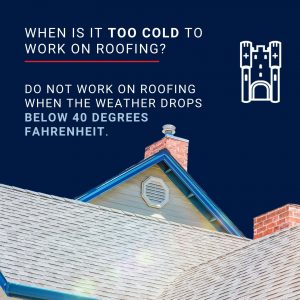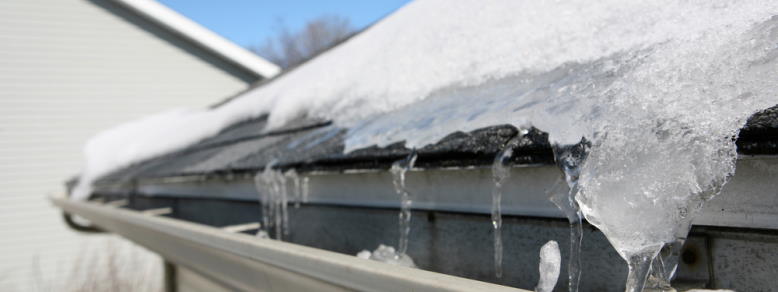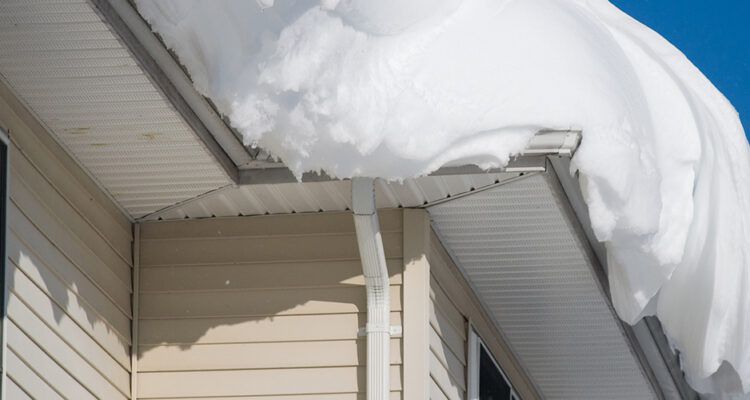Imagine you wake up to a blustery winter morning, cup of hot coffee in hand, and ponder a question that lingers in your mind: What temperature is too cold to replace a roof? As you sip your warm beverage, thoughts swirl in your head about whether it’s feasible to undergo such a task in the midst of plummeting temperatures. In this article, we will explore the optimal temperature range for roof replacement and shed light on the implications of working in extreme cold. So, bundle up and let’s embark on this chilly adventure to discover the answer to your burning question.

Factors to Consider
Roofing Material
When it comes to replacing your roof, one of the key factors to consider is the type of roofing material you will be using. Each roofing material has its own set of characteristics and properties, and these can determine how well it performs in different weather conditions, including cold temperatures. Some materials may be more prone to cracking or becoming brittle in the cold, while others may be more durable and better suited for colder climates.
Manufacturer’s Guidelines
Another factor to consider is the manufacturer’s guidelines for your specific roofing material. Manufacturers often provide recommendations on the ideal temperature range for installing and working with their products. These guidelines are based on extensive testing and research to ensure the best performance and longevity of the roofing materials. It’s important to consult these guidelines before proceeding with a roof replacement project in cold weather.
Temperature Range
The temperature range is a critical aspect to consider when planning a roof replacement in cold weather. Extremely low temperatures can affect the installation process and the overall performance of the roofing materials. It’s important to understand the minimum temperature requirements for your specific roofing material to ensure proper installation and to avoid any potential issues or damages.
Time of Year
The time of year plays a significant role in determining whether it’s suitable to replace your roof in cold weather. Depending on your location, winter months can bring freezing temperatures, snow, and ice, which can make the process more challenging and potentially hazardous. However, some roofing materials are designed to withstand colder climates and can be installed safely during the winter with the right precautions and adaptations.
Effects of Cold Weather on Roof Installation
Material Performance
Cold weather can have a significant impact on the performance of roofing materials. Some materials may become stiff and less pliable, making them more difficult to work with and install. This can result in potential damage during the installation process, such as cracking or breaking. It’s essential to choose a roofing material that is designed to withstand lower temperatures and maintain its flexibility for proper installation and long-term performance.
Adhesive and Sealant Performance
Adhesives and sealants are crucial components of the roof installation process, as they provide the necessary waterproofing and protection against the elements. In cold weather, adhesives and sealants may take longer to cure or may not adhere properly, compromising the overall integrity of the roof. It’s vital to use adhesives and sealants that are specifically formulated for cold weather applications to ensure proper bonding and long-lasting results.
Safety Risks
Performing roof replacement in cold weather can pose safety risks for both the roofing professionals and homeowners. Slippery surfaces due to ice or snow can increase the likelihood of accidents and injuries. Cold temperatures can also affect the dexterity and agility of workers, making it more difficult to handle tools and materials safely. It’s crucial to take appropriate safety measures and precautions to minimize risks and ensure a safe working environment during cold weather roofing projects.
Recommended Temperature Range for Roof Replacement
Asphalt Shingles
For asphalt shingles, the recommended temperature range for installation is typically above 40°F (4.4°C). Below this temperature, the shingles can become brittle and may not seal properly, which can lead to water damage and other issues. It’s best to wait for milder weather conditions if you are planning to install asphalt shingles.
Metal Roofing
Metal roofing is known for its durability and resilience, making it suitable for colder climates. It can be installed in temperatures as low as 20°F (-6.7°C) but requires special considerations to prevent condensation and ensure proper installation. Consult with a professional contractor to determine the best approach for your metal roof replacement in cold weather.
Slate or Tile Roofing
Slate and tile roofing materials are highly resistant to cold temperatures and can be installed throughout the year, including during winter months. The key consideration is to ensure that there is no moisture or ice buildup on the roof surface during the installation process. Proper insulation and ventilation are essential for maintaining the longevity and performance of slate or tile roofing in cold climates.
EPDM or TPO Roofing
EPDM (ethylene propylene diene terpolymer) and TPO (thermoplastic olefin) roofing membranes are commonly used for flat or low-slope roofs. These materials are designed to be flexible and durable, even in extremely low temperatures. EPDM and TPO membranes can be installed in temperatures as low as -20°F (-28.9°C). However, it’s recommended to consult with a professional roofing contractor to ensure proper installation and adherence to manufacturer’s guidelines.
Precautions and Adaptations for Cold Weather Roofing
Heating Equipment
One of the most crucial precautions for cold weather roofing is the use of heating equipment. Heating equipment can help warm up the roofing materials, adhesives, and sealants, making them more pliable and easier to work with. This can help prevent potential damages and ensure proper installation. It’s important to use heating equipment that is specifically designed for roofing applications and follow all safety guidelines.
Adhesive Modification
In cold temperatures, certain adhesives and sealants may not perform optimally. One adaptation for cold weather roofing is to modify the adhesives and sealants by adding accelerators or using products specifically formulated for low-temperature applications. These modifications can help improve the curing time and ensure proper bonding in colder conditions. It’s essential to consult with a professional roofing contractor to determine the best adhesive options for your specific project.
Safety Measures
Safety should always be a top priority during any roofing project, especially in cold weather. In addition to the usual safety precautions, such as wearing protective gear and using proper fall protection systems, additional measures should be taken in cold weather. This includes regularly checking and clearing the work area of ice and snow, using non-slip footwear, and ensuring proper lighting for visibility. Adequate breaks and warm-up periods should be allowed for workers to prevent cold-related injuries.

Benefits of Cold Weather Roof Replacement
Availability and Pricing
One of the benefits of scheduling a roof replacement during colder months is the increased availability and pricing options. The demand for roofing contractors tends to be lower during the winter season, which means you may have more options to choose from and potentially negotiate better prices. By taking advantage of off-peak times, you can save money and secure a reputable contractor for your roof replacement project.
Contractor Schedules
During the warmer months, roofing contractors are typically busier with a higher volume of projects. This can result in longer wait times and scheduling conflicts. However, in colder weather, roofing contractors may have more flexibility in their schedules and can complete your roof replacement in a shorter time frame. It’s important to consult with contractors well in advance and discuss their availability for a smooth and efficient process.
Reduced Heat Stress
Replacing a roof can be physically demanding work, especially in hot weather conditions. Cold weather can provide relief from heat stress for workers, allowing them to work more comfortably and efficiently. Additionally, colder temperatures can also reduce the risk of heat-related illnesses and worker fatigue, promoting a safer working environment.
Case Studies of Cold Weather Roof Replacements
Residential Roof Replacement
A homeowner in a northern climate found that their roof was in need of replacement during the winter months. They consulted with a professional roofing contractor who determined that their asphalt shingles could be safely installed in the current temperature range. The contractor used heating equipment to warm up the materials and adhesives, ensuring proper installation. The roof replacement was completed successfully, providing the homeowner with a reliable and weather-resistant roof throughout the winter season.
Commercial Roof Replacement
A commercial building owner in a cold climate decided to replace their aging EPDM roofing membrane during the winter months. The owner worked closely with a reputable roofing contractor who specialized in cold weather installations. The contractor used adhesive modifications that were suitable for low temperatures and ensured proper bonding and integrity of the roof. The EPDM roofing membrane was installed successfully, providing the commercial building with enhanced durability and protection against the elements.

Steps to Take Before Cold Weather Roof Replacement
Inspecting and Repairing Damages
Before proceeding with a cold weather roof replacement, it’s crucial to thoroughly inspect the existing roof for any damages or issues. Addressing repairs beforehand can help prevent further damage during the installation process and ensure a solid foundation for the new roof. Identifying and fixing any leaks, weak spots, or structural concerns will contribute to the long-term performance and durability of the new roof.
Removing Debris
Clearing the roof of any debris, such as leaves, branches, and dirt, is essential before starting the replacement process. Debris can hinder the proper installation of the new roof and compromise its performance. Additionally, debris can trap moisture, which can lead to mold and rot. By thoroughly cleaning the roof, you create a clean and suitable surface for the installation of the new roofing materials.
Scheduling Inspections
Before starting a roof replacement project in cold weather, it’s important to schedule inspections with a professional roofing contractor. These inspections will help assess the condition of the existing roof, determine the feasibility of a cold weather replacement, and provide expert advice on the best approach for your specific situation. Consulting with professionals will ensure that all necessary precautions and adaptations are taken to achieve a successful and long-lasting roof replacement.
Common Misconceptions About Cold Weather Roofing
Roofing Can’t be Done in Winter
One common misconception is that roofing cannot be done in winter. While there are certain limitations and adaptations required for cold weather roofing, it is possible to replace a roof successfully during colder months. By following the manufacturer’s guidelines, using proper heating equipment, and employing safety measures, roofing contractors can perform installations in low temperatures and ensure the performance and integrity of the new roof.
Quality Compromises
Some homeowners may worry that installing a roof in cold weather may compromise the quality and durability of the materials. While it’s true that extreme cold can affect the performance of certain roofing materials and adhesives, proper precautions and adaptations can mitigate these concerns. Consulting with professional roofing contractors who specialize in cold weather installations and following manufacturer’s guidelines will help ensure that the quality and longevity of the new roof are not compromised.
Warranty Concerns
Another misconception is that installing a roof in cold weather may void or impact the warranty of the roofing materials. It’s important to review the manufacturer’s warranty and consult with a professional roofing contractor to understand any specific temperature requirements or limitations. By adhering to the guidelines, using approved materials, and working with experienced contractors, you can maintain the validity of your warranty and enjoy the benefits and protection it offers.

Preparing Your Home for a Cold Weather Roof Replacement
Landscape Protection
Before starting a cold weather roof replacement, it’s important to protect your surrounding landscape. Heavy machinery, tools, and materials can potentially damage plants, flowerbeds, and other outdoor features. Taking the time to cover and secure vulnerable areas can help prevent unnecessary damage and ensure a clean and tidy work area throughout the roof replacement process.
Proper Ventilation
Proper ventilation is essential during a roof replacement, regardless of the weather conditions. In cold weather, it’s important to ensure that there is adequate air circulation to avoid moisture buildup and condensation. Proper ventilation will help prevent potential damage to the roofing materials and protect the structural integrity of the roof. Consult with professionals to evaluate and improve the ventilation system in your home as needed.
Interior Preparations
Preparing the interior of your home for a cold weather roof replacement involves taking measures to protect your belongings and minimize disruptions. Move furniture, valuables, and fragile items away from the areas directly below and adjacent to the roof. This will protect them from any potential debris or accidental damage during the installation process. Communicate with the roofing contractor about the schedule and expected timeline to coordinate any necessary accommodations.
Conclusion
When considering a roof replacement in cold weather, there are several critical factors to keep in mind. The choice of roofing material, adherence to manufacturer’s guidelines, the recommended temperature range, and the timing of the project all play significant roles in ensuring a successful and durable roof replacement. By taking appropriate precautions, such as using heating equipment, modifying adhesives, and implementing safety measures, cold weather roofing can be carried out effectively.
Understanding the benefits of cold weather roof replacement, such as increased availability and pricing options, shorter contractor schedules, and reduced heat stress, can motivate homeowners to consider this option. Real-life case studies of successful cold weather roof replacements demonstrate the feasibility and positive outcomes of such projects.
Prior to starting a cold weather roof replacement, it’s essential to take important steps such as inspecting and repairing damages, removing debris, and scheduling professional inspections. Addressing these necessary preparations will contribute to the overall success and longevity of the new roof.
Dispelling common misconceptions about cold weather roofing, including the belief that roofing cannot be done in winter and concerns about compromises in quality and warranty, is crucial in promoting informed decision-making. By following professional guidance, preparing the home for the installation, and ensuring proper ventilation, homeowners can confidently proceed with a cold weather roof replacement and enjoy the benefits of a new, weather-resistant roof.
